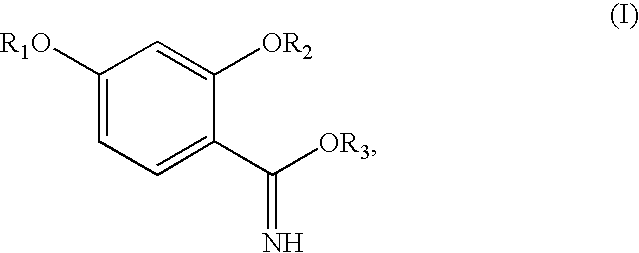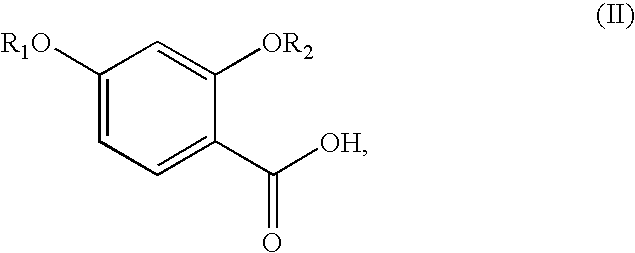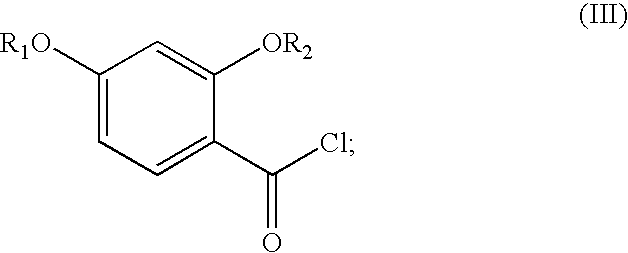Synthesis of benzimidate from benzoic acid
a technology of benzimidate and benzoic acid, which is applied in the preparation of isocyanic acid derivatives, drug compositions, extracellular fluid disorders, etc., can solve the problems of short half-life, serious patient compliance and treatment cost, and the inability to commercially sell alkyl 2,4-dihydroxybenzimidates, etc., and achieves the effect of inexpensive and readily available starting materials
- Summary
- Abstract
- Description
- Claims
- Application Information
AI Technical Summary
Benefits of technology
Problems solved by technology
Method used
Image
Examples
example 1
2,4-Dihydroxybenzoic acid was reacted with sodium hydride and benzyl bromide in dimethylformamide (DMF) to give a compound protected with benzyl groups at hydroxyl and carboxylic acids moieties in a 91% yield. The benzyl group was removed from the carboxylic acid moiety by refluxing it with 2 N sodium hydroxide in dioxane, followed by acidifying the mixture, to give 2,4-dibenzyloxybenzoic acid in 83% yield.
2,4-Dibenzyloxybenzoic acid was reacted with oxalyl chloride in toluene and DMF at 0-25° C. to give an acid chloride. The acid chloride was reacted with aqueous ammonia in methylene chloride to yield 87% (over 2 steps) of 2,4-dibenzyloxybenzamide. 2,4-Dibenzyloxybenzamide was reacted with triethyloxonium hexafluorophosphate in methylene chloride to yield 69% of ethyl 2,4-dibenzyloxybenzimidate. The ethyl 2,4-dibenzyloxybenzimidate was hydrogenated over a palladium / carbon catalyst with 1 atmosphere of hydrogen gas in ethanol, to yield 75% of ethyl 2,4-dihydroxybenzimidate. The over...
example 2
35 mg of R- and S-4,5-dihydro-2-(2,4-dihydroxyphenyl)-4-methylthiazole-4-carboxylic acid were dissolved in 1 ml of a mixture of 9% N-methyl-pyrrolidone, 9% v / v 2-hexanol, 10% v / v Rhodafac RE 610, 5% v / v Soprophor FL and 68% v / v water by heating to 50° C. in a 5 mL vial. After the product was completely dissolved, the microemulsion was cooled down to room temperature and agitated with a shaking machine (350 rpm). During two hours, no spontaneous crystallization was observed. The mixture was then seeded with two drops of a dilute, finely ground suspension of pure S-product crystals grown under similar conditions. After two hours of shaking, the resulting crystals were filtered off, washed with water and dried in a gentle nitrogen stream. The procedure yielded 5.4 mg (15.4%) of colorless crystals, with a greater than 90% purity of the S entantiomer.
example 3
4.00 g (S)-2-methylcysteine hydrochloride (23.3 mmol,1.0 meq) and 3.14 g 2,4-dihydroxy benzonitrile (23.3 mmol, 1.0 meq) were suspended in 40 mL ethanol. After degassing this mixture with nitrogen (30 min) 4.95 g triethylamine (6.8 mL, 48.9 mmol, 2.05 meq) were added. The obtained suspension was heated under reflux in an atmosphere of nitrogen for 20 hours and then cooled to room temperature. From this suspension ethanol was evaporated under reduced pressure until an oil (20% of the initial volume) was obtained. This oil was dissolved in 50 mL water. The solution was adjusted to pH 7.5 with 1.20 ml 20% KOH and was extracted two times each with 20 mL methyl t-butyl ether (MTBE). The aqueous layer was separated, adjusted with 20% KOH to pH 11 and again extracted two times each with 20 mL MTBE. After separating the aqueous layer the pH was set with concentrated HCl to 7.5 and traces of MTBE were distilled off. Then the aqueous solution was acidified with 1.50 ml concentrated HCl to pH ...
PUM
 Login to View More
Login to View More Abstract
Description
Claims
Application Information
 Login to View More
Login to View More - R&D
- Intellectual Property
- Life Sciences
- Materials
- Tech Scout
- Unparalleled Data Quality
- Higher Quality Content
- 60% Fewer Hallucinations
Browse by: Latest US Patents, China's latest patents, Technical Efficacy Thesaurus, Application Domain, Technology Topic, Popular Technical Reports.
© 2025 PatSnap. All rights reserved.Legal|Privacy policy|Modern Slavery Act Transparency Statement|Sitemap|About US| Contact US: help@patsnap.com



